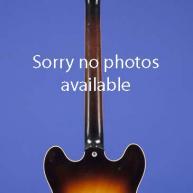"One Owner, Low Mileage" -- A Very Rare 1929 National Spanish (Roundneck) Tricone Resonator
German silver body. "Style 2 1/2" with "wild roses" engraved on the coverplate as well as on the body. Three resonator cones, with two cones on the bass side and one cone on the treble side. T-shaped bridge cover and handrest. Grid-pattern soundholes on the upper body. Spanish (roundneck) style with mahogany neck and bound single-layer ebony fretboard with 12 frets clear of body and inlaid pearl dot position markers. Slotted headstock with "National" shield logo decal. Side-mounted tuning gears. Serial number ("0876") stamped into the body by the endpin. Apart from some "capo" wear to the back of the neck, this one owner guitar is in remarkably fine condition. Housed in the original black leather hardshell case with purple plush lining. Complete with the original capo and a handful of original accessories, some of which were hand-made by the owner. A real piece of history from the "Great Depression."
"One of the most fascinating and charismatic instruments ever made, the National resonator guitar, first went into production 75 years ago...The 1920s guitar players, drowned out by every other instrument on the bandstand, so easily dispensed with, needed a super-loud guitar. In the mid 1920s a Hawaiian guitar player, George Beauchamp, approached two friends who ran a violin shop in Los Angeles, John and Rudy Dopyera, with an idea for a guitar which worked on the same principle as the Victrola gramophone. The Dopyera brothers approved: they'd likely already seen an English device called the Stroh violin, which passed the vibrations from the bridge to a small, sensitive circular disc and then on to an unwieldy gramophone horn. But they had a better idea: resonators built into the body of the guitar itself...Under the brilliant organizational and manufacturing skills of John Dopyera the National triplate quickly took shape, and in 1926 the earliest all-handmade prototypes were ready...For any musician of the time, acquiring a National guitar meant a massive investment. The cheapest tricone, the very first triple-resonator Nationals, cost $125, the most expensive models $195. Nationals were unequivocally louder than any other guitar on the market, and for a few years, provided you could raise the cash, possessing one of these mechanically amplified guitars guaranteed that you'd be heard, seen, and remembered" (Rick Batey, The American Blues Guitar, pp. 72-74).
"National tricone guitars had bodies made of German silver, also known as white brass or nickel silver. An alloy of roughly around 65% copper, 20% zinc, and 15% nickel, it's the same material we use today for fretwire. The resonator system consisted of three 6 in. diameter cones, each one of almost pure aluminum, lathe-spun extremely thin -- as little as 0.005 in. -- and embossed with a radiating pattern of lines for the sake of added strength. The centers of the three cones were connected by a T-shaped bridge bar, which incorporated a maple insert which the strings rested directly upon. A triangular coverplate protected the delicate cones from nasty accidents. National triplates have a distinctly different sound to the later, and cheaper, single-cone models: not as punchy and banjo-like, but sweet and rich, full of natural harmonics and a faint but unmistakable sense of natural reverb. Although a few blues players -- Tampa Red, Black Ace, Memphis Minnie, and Peetie Wheatstraw -- laid their hands on tricones, most of these expensive guitars went to jazz, calypso, and Hawaiian players, the company's preferred customers" (Rick Batey, The American Blues Guitar, p. 73).
"National introduced squareneck tri-cone guitars in 1927 and roundnecks a year later. No doubt, the tri-cone's immediate association with Hawaiian music helped squareneck models outsell roundnecks by about three to one. Because of the relative rarity of roundnecks and the fall in popularity of Hawaiian music, roundneck tri-cones are much more valued by collectors today" (George Gruhn and Walter Carter, Acoustic Guitars and Other Fretted Instruments, p. 226).
Translate:

